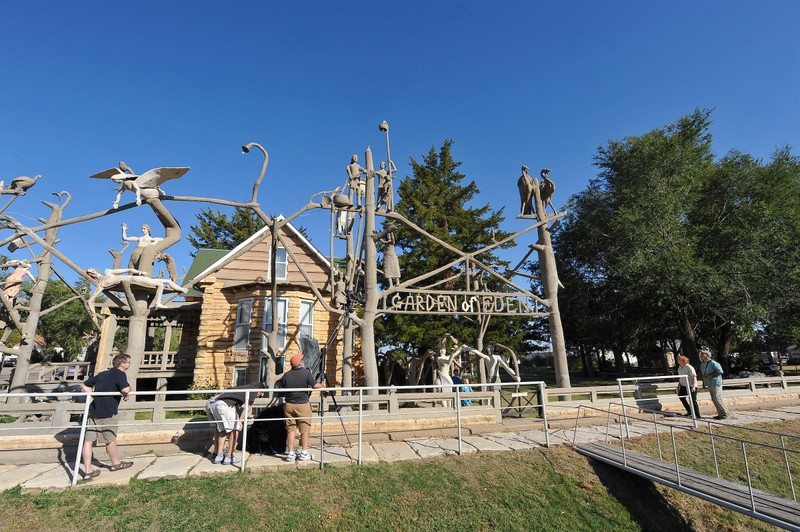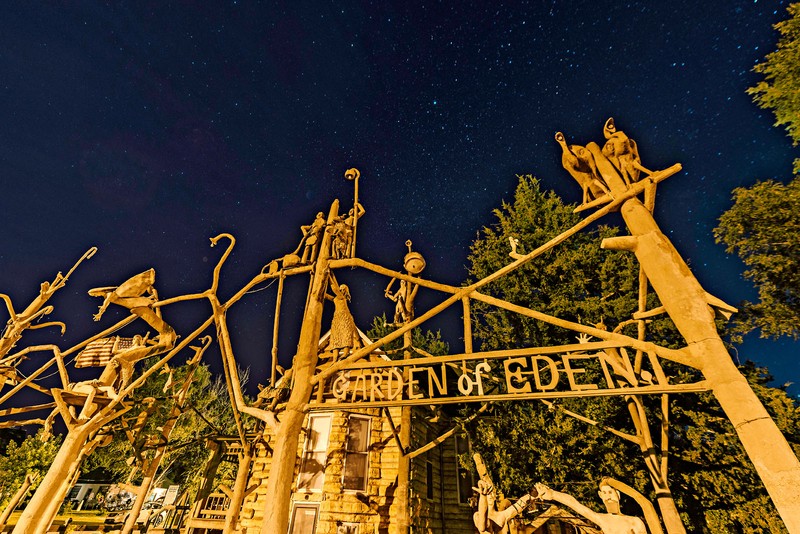S. P. Dinsmoor’s Garden of Eden
Introduction
Text-to-speech Audio
Considered one of the best roadside attractions in the United States, S. P. Dinsmoor’s Garden of Eden is a bizarre collection of disturbing yet captivating statues, Biblical and political iconography, and even a mausoleum containing the (mostly) preserved body of Dinsmoor himself.
Images
The Garden of Eden and Cabin Home in Lucas, Kansas.

The gates of the Garden of Eden at night.

Backstory and Context
Text-to-speech Audio
S. P. Dinsmoor led a storied life, serving in the Union Army as a nurse, joining the Freemasons, teaching school, and finally moving to Lucas, Kansas, to start his own farm. But it was what came after his retirement that made his name and put his tiny town on the map for more than a century to come.
Dinsmoor created the Cabin Home and its surrounding Garden of Eden between 1907 and 1928. The cabin is made of lengths of limestone stacked to resemble logs, and each door and window is a different size, giving the cabin a funhouse-esque appearance. Even more fantastical is the garden, which is populated by bizarre sculptures, from religious imagery like the giant Eye of God (equipped with a blinking electric lightbulb for an iris) and a glowing horned devil to Populist political iconography inspired by the burgeoning 20th-century labor movement.
The Populist statuary in the garden is no coincidence. Even before he built his eye-catching Garden of Eden, Dinsmoor was highly visible as a Populist leader in Lucas, and chief among his causes was organizing against monopolies. He even formed the United Order of Anti-Monopolies, an egalitarian secret society of men and women. Dinsmoor campaigned unsuccessfully for a seat in the Kansas house in 1898 and was an active supporter of socialist and Populist causes throughout his lifetime. While building the Garden of Eden, Dinsmoor was inspired to give his sculptures a more political edge after the 1914 Ludlow Massacre, in which National Guard troops opened fire on striking mineworkers and their families.
While Dinsmoor himself claimed to be “bughouse,” his Garden of Eden was created with shrewd calculation. Built near the town train station, visitors’ eyes were inevitably caught by the property’s blinking lights and peculiar imagery. When passersby stopped outside to gawk, Dinsmoor urged them inside to pay for a tour using a speaking tube that produced sound through the mouth of an angel statue. Not only did the steady stream of visitors provide Dinsmoor’s income, but they also became an audience for Dinsmoor’s ardent political messages.
After Dinsmoor’s death in 1937, the property was sold off and sat abandoned for decades. It inspired such apprehension in local residents that the cabin and gardens remained remarkably untouched beneath a layer of vines and mold, avoiding vandalism and theft.
In 2012, the Kohler Foundation undertook the massive project of restoring the Cabin Home and Garden of Eden, and it now attracts more than 10,000 visitors each year. Although a crack in the glass lid of his coffin allowed in enough air and moisture to rot his head, Dinsmoor’s body remains mostly intact to enjoy the spectacle from inside a mausoleum on the property.
Sources
Hasselle-Newcombe, Suzanne . Cementing His Political Views: S. P. Dinsmoor and the Garden of Eden. KANSAS HISTORY, vol. 24, no. 2. Summer 2001. https://www.kshs.org/publicat/history/2001summer_hasselle.pdf.
http://www.gardenofedenlucas.org/
https://www.kohlerfoundation.org/preservation/preserved-sites/s.p.-dinsmoors-garden-of-eden/
https://www.roadsideamerica.com/story/2103
Kansas Tourism
COURTESY OF MIDWEST LIVING / Doug Stremel via Kansas Tourism
